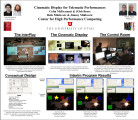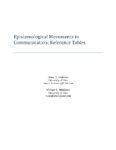1 - 25 of 10
| Creator | Title | Description | Subject | Date | ||
|---|---|---|---|---|---|---|
| 1 |
 |
Gehl, Robert W. | The archive and the processor: the internal logic of web 2.0 | In Web 2.0, there is a social dichotomy at work based upon and reflecting the underlying Von Neumann architecture of computers. In the hegemonic Web 2.0 business model, users are encouraged to process digital ephemera by sharing content, making connections, ranking cultural artifacts, and producing ... | 2011 | |
| 2 |
 |
Gehl, Robert W. | Building a blog cabin during a financial crisis: circuits of struggle in the digital enclosure | One of the most pressing questions facing television studies is how to understand the migration of media production and consumption onto web applications which depend on user-generated content. Scholars inspired by the political economy of communication (PEC) tradition have focused on how the accumu... | 2011 | |
| 3 |
 |
Miklavcic, Jimmy; McDermott, Colin Hull; Bross, Joshua Lee; Miklavcic, Elizabeth Ann | Cinematic display for telematic performances | The InterPlay is a live telematic performance that occurs simultaneously in multiple sites across the globe, streamed over the internet through the Access Grid videoconference system, then processed, mixed and projected before an audience. | Trapeze Interactive Poster | 2010-01-13 |
| 4 |
 |
Anderson, James A. | Empirical theories in communication reported in 2014 & 2015 | All empirical articles in seven journals for the volume years 2014 and 2015 from: Communication Monographs Communication Research Human Communication Research Journalism & Mass Communication Quarterly Journal of Broadcasting and Electronic Media Journal of Communication Management Communication Quar... | Empirical theories; Communication | 2015 |
| 5 |
 |
Anderson, James A. | Epistemological movements in communication: reference tables | This publication supports the chapter EpistemologicalMovements in Communication: An Analysis o f Empirical and Rhetorical/Critical Scholarship to be published in the NCA Centennial Volume. It provides the extended data tables that could not be presented in the chapter because of space limitations. I... | 2014-01 | |
| 6 |
 |
Gehl, Robert W. | The politics of cultural programming in public spaces | In our digital media saturated lives, where we spend increasing amounts of time in "virtual worlds" such as Second Life or online on blogs and video sites, it can be easy to forget about public spaces. Unlike much content in virtual worlds, cultural programs in public spaces are events that are live... | 2007 | |
| 7 |
 |
Anderson, James A. | Unduplicated empirical theories in communication reported in 2015 | All empirical articles in seven journals for the volume year 2014 from: Communication Monographs Communication Research Human Communication Research Journalism & Mass Communication Quarterly Journal of Broadcasting and Electronic Media Journal of Communication Management Communication Quarterly 254 ... | Empirical theories; Communication | 2015 |
| 8 |
 |
Anderson, James A. | Unduplicated empirical theories of 2014 | All empirical articles in seven journals for the volume year 2014: Communication Monographs Communication Research Human Communication Research Journalism & Mass Communication Quarterly Journal of Broadcasting and Electronic Media Journal of Communication Management Communication Quarterly 231 artic... | Empirical theories; Social science theories; Communication theories | 2014 |
| 9 |
 |
Anderson, James A. | Unduplicated empirical theories of 2016 | In 2016, the seven mainline, empirical journals-Communication Monographs, Communication Research, Human Communication Research, Journalism & Mass Communication Quarterly, Journal of Broadcasting & Electronic Media, Journal of Communication, and Management Communication Quarterly-produced 253 empiric... | 2016 | |
| 10 |
 |
Gehl, Robert W. | YouTube as archive: who will curate this digital wunderkammer? | At first glance, the ease with which individuals can access and contribute to YouTube sets it in direct opposition to large corporate media outlets with their top-down mode of dissemination. However, in this paper, I argue that despite these seemingly democratic features, YouTube is better understoo... | 2009 |
1 - 25 of 10
